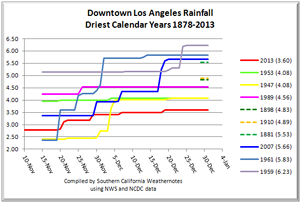

Downtown Los Angeles Rainfall
Driest Calendar Years 1878-2013.
Since January 1 Downtown Los Angeles has recorded only 3.60 inches of rain, making it the driest calendar year since recordkeeping began in July of 1877. The previous record of 4.08 inches was set in 1953 and 1947. Downtown Los Angeles averages about 15 inches of rain in a calendar year.
Precipitation composites for years with comparable PD0-AMO indices constructed by Dr. Klaus Wolter of the Cooperative Institute for Research in Environmental Sciences at the University of Colorado appears to have anticipated this year's drought in Southern California. While Oct-Dec anomalies for Southern California were -0.5 to -0.7 SD below the 1895-2000 Longterm Average, Jan-Mar anomalies were -0.1 to -0.3 SD below average. Assuming the anomaly maps to be correlative the drought's stranglehold on Southern California may weaken somewhat over the next three months.
To get an idea of how the precipitation anomaly might vary over the next three months, the US Climate Division Dataset Mapping Page was used to recreate the standardized Oct-Dec precipitation anomaly and Jan-Mar precipitation anomaly maps using the same years as Dr. Wolter's composites. Then standardized composite precipitation anomaly maps were constructed for the months of January, February, and March. Based on these composites some lessening of the severity of the drought in Southern California is suggested throughout the period Jan-Mar with the biggest improvement indicated in March -- except for coastal Southern California. A map showing the composite precipitation anomaly in inches for the period October to March was also generated.
While today's medium range forecasts and 6-10 day and 8-14 day precipitation outlooks aren't particularly encouraging there are some straws to grasp. The AO Index, which has been positive for most of the rainy season is now negative and the Global Wind Oscillation (GWO) is in its first full orbit into positive AAM territory in several months. Whether these changes eventually result in rain for Southern California we'll just have to see.
More information about Southern California weather and climate can be found using our WEATHER LINKS page.